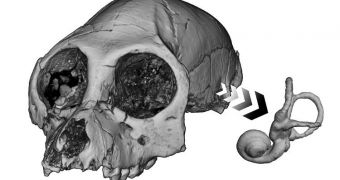According to researchers at the Pennsylvania State University (Penn State), the movement patterns of ancient primates could be revealed by analyzing skulls and other fossilized remains left behind by the creatures. The team was part of an international collaboration of researchers that led a new study.
The group used computed tomography (CT) scans of very old primate skulls and other fragments. The samples were collected from around the world, and this was very important for the research. One of its main goals was to figure out how these species moved.
It is suspected that some of these creatures left behind no known fossils. Therefore, their very existence can only be reconstructed through indirect studies. The team began its study by conducting CT scans on the inner ears of living primate species.
Experts then carried out a similar analysis on the inner ears of ancient creatures, looking for similarities and differences between the two datasets. The bony labyrinth of the inner ear was the main point of interest. The structure is made up of the cochlea, the vestibule and three semicircular canals.
The last-named are responsible for sensing the motions of the head, and also play an important role in synchronizing these movements with visual perception. This enables us to perceive reality as a seamless continuum, blurring the boundaries between senses.
“Almost in every case where there is a fossilized skull, the semicircular canals are present and well preserved. They are embedded in a very dense part of the skull and so are protected,” explains Penn State expert Timothy Ryan.
He holds an appointment as an assistant professor of anthropology, geosciences and information sciences and technology at the university, and was also a member of the international research team.
Details of the investigation appear in the June 13 issue of the esteemed journal Proceedings of the Royal Society B: Biological Sciences. By studying the inner ear and its semicircular canals, researchers can figure out whether species moved with agility, or whether they moved more slowly.
There is a great difference between moving by leaping, swinging or traveling. Monkeys' modes of locomotion differ considerably from those of gibbons, which in turn differ from those of gorillas.
Funds for the research were provided by the US National Science Foundation (NSF) and the National Science and Engineering Council (NSEC) of Canada.
“The research suggests that the last common ancestor of Old World monkeys and apes would have been an animal of medium agility, much like living macaques,” Ryan concludes.

 14 DAY TRIAL //
14 DAY TRIAL //